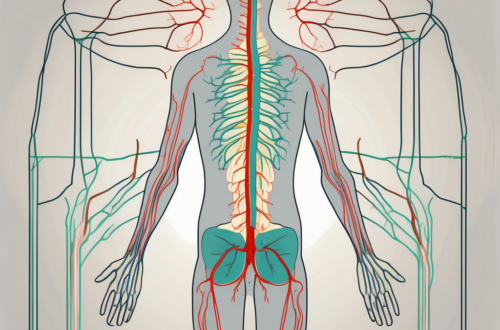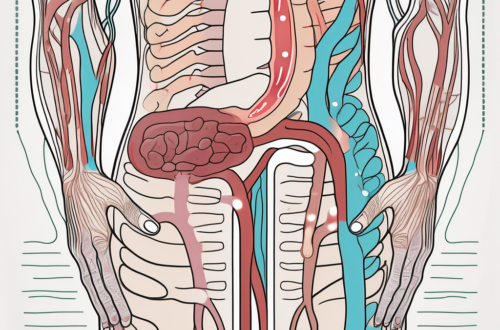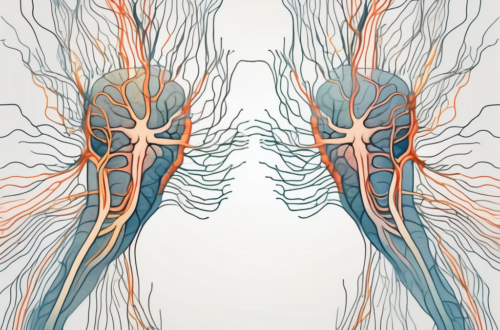Acetylcholine is a neurotransmitter that plays a vital role in the functioning of both somatic nerve fibers and parasympathetic nerve fibers within the nervous system. Understanding the complexities of neurotransmitters is crucial in comprehending the significance of acetylcholine and its impact on bodily processes.
Understanding Neurotransmitters
Neurotransmitters are chemical messengers that facilitate communication between nerve cells, or neurons, in the nervous system. They play a crucial role in transmitting nerve impulses across synapses, the junctions between neurons. Without neurotransmitters, our bodies would not be able to carry out even the most basic functions.
Neurotransmitters are synthesized within neurons and stored in vesicles until they are needed for transmission. Once released, they bind to specific receptors on the postsynaptic neuron, which triggers a response. The balance and regulation of neurotransmitters are essential for maintaining proper neuronal function.
But what exactly are neurotransmitters? Let’s delve deeper into their definition and function.
Definition and Function of Neurotransmitters
Neurotransmitters are molecules that transmit signals between neurons. They are involved in a wide range of physiological and cognitive processes, including motor control, mood regulation, memory formation, and the regulation of vital bodily functions like heart rate and digestion.
Each neurotransmitter has specific functions and associated pathways within the nervous system. For example, dopamine is involved in reward and motivation, serotonin regulates mood and sleep, and glutamate is the most abundant excitatory neurotransmitter in the brain.
Neurotransmitters can have excitatory or inhibitory effects on target neurons, depending on the receptors they bind to. Excitatory neurotransmitters increase the likelihood of an action potential in the postsynaptic neuron, while inhibitory neurotransmitters decrease the likelihood of an action potential. The complexity of neurotransmission allows for the precise control and coordination of diverse bodily functions.
Now that we have a better understanding of neurotransmitters in general, let’s explore the importance of a specific neurotransmitter – acetylcholine.
The Importance of Acetylcholine in the Nervous System
Acetylcholine is one of the most important neurotransmitters in the nervous system. It is involved in the transmission of nerve impulses in both the somatic and parasympathetic pathways.
In the somatic nervous system, acetylcholine plays a crucial role in transmitting signals from motor neurons to skeletal muscles, allowing for voluntary movements. Without acetylcholine, we would not be able to perform basic actions such as walking, talking, or even blinking.
Through the parasympathetic pathway, acetylcholine regulates vital functions such as heart rate, digestion, and glandular activity. It helps maintain a balanced state in our body, ensuring that our heart beats at a normal rate, our food is properly digested, and our glands secrete necessary hormones.
Given its involvement in critical bodily processes, any disruption in the production, release, or reception of acetylcholine can lead to various neurological disorders. For example, Alzheimer’s disease is characterized by a significant decrease in acetylcholine levels in the brain, resulting in memory loss and cognitive decline.
Understanding the role of acetylcholine and other neurotransmitters in the nervous system is crucial for advancing our knowledge of neurological disorders and developing effective treatments.
Acetylcholine in Somatic Nerve Fibers
The somatic nervous system consists of motor neurons that control voluntary movements and sensory neurons that convey sensory information to the brain. Acetylcholine is vital for transmitting signals from the motor neurons to the skeletal muscles, allowing us to perform conscious movements.
Acetylcholine, a neurotransmitter, plays a crucial role in the somatic nervous system. It is involved in the transmission of nerve impulses from motor neurons to the skeletal muscles, enabling us to execute voluntary movements with precision and coordination.
The Somatic Nervous System Explained
The somatic nervous system consists of two major components: the sensory division and the motor division. The sensory division is responsible for transmitting sensory information from the body’s periphery to the central nervous system, while the motor division controls voluntary movements by sending signals from the brain to the skeletal muscles.
Within the somatic nervous system, acetylcholine acts as a key mediator in the motor division. It facilitates the transmission of nerve impulses from motor neurons to the skeletal muscles, allowing us to perform a wide range of voluntary actions, such as walking, running, and grasping objects.
Acetylcholine is released from motor neurons at the neuromuscular junction (NMJ), where it binds to nicotinic acetylcholine receptors on the surface of muscle fibers. This binding initiates a cascade of events that ultimately leads to muscle contraction.
Furthermore, the regulation of acetylcholine release and receptor activity is essential for coordinated muscle movements. Imbalances or disruptions in the availability or function of acetylcholine at the NMJ can result in various neuromuscular disorders, affecting muscle strength, causing paralysis, and impairing motor control.
The Impact of Acetylcholine on Somatic Nerve Function
Acetylcholine exerts its influence on somatic nerve function through its actions at the neuromuscular junction (NMJ). At the NMJ, acetylcholine is released from motor neurons and binds to nicotinic acetylcholine receptors on the surface of muscle fibers. This binding initiates a series of events that culminate in muscle contraction.
Moreover, the release and reception of acetylcholine at the NMJ are precisely regulated to ensure smooth and coordinated muscle movements. Any disruptions in this process can lead to neuromuscular disorders, such as myasthenia gravis, where the immune system mistakenly attacks acetylcholine receptors, resulting in muscle weakness and fatigue.
Additionally, acetylcholine plays a role in muscle memory and learning. Studies have shown that the release of acetylcholine during repetitive movements helps strengthen the connections between motor neurons and muscle fibers, enhancing the efficiency and accuracy of future movements.
Understanding the role of acetylcholine in somatic nerve function is crucial for developing treatments for various neuromuscular disorders. Researchers are exploring ways to modulate acetylcholine release and receptor activity to restore normal muscle function in conditions such as muscular dystrophy and spinal cord injuries.
Acetylcholine in Parasympathetic Nerve Fibers
In addition to its role in the somatic nervous system, acetylcholine is also crucial in the parasympathetic nervous system. The parasympathetic pathway works in opposition to the sympathetic pathway and is responsible for promoting rest, relaxation, and digestion.
Overview of the Parasympathetic Nervous System
The parasympathetic nervous system is one of the two main divisions of the autonomic nervous system, which controls involuntary bodily functions. It works alongside the sympathetic nervous system, balancing its effects by promoting restful states and conserving energy.
Acetylcholine acts as the primary neurotransmitter in the parasympathetic pathway, transmitting signals to specific target organs and tissues. It regulates bodily functions such as heart rate, gastrointestinal motility, and glandular secretions.
The Influence of Acetylcholine on Parasympathetic Nerve Activity
Acetylcholine exerts its effects in the parasympathetic nervous system by activating muscarinic acetylcholine receptors. These receptors are found on various target cells, including smooth muscles, cardiac muscles, and exocrine glands.
Activation of muscarinic receptors by acetylcholine leads to a range of responses, such as relaxation of smooth muscles, decreased heart rate, increased glandular secretions, and enhanced digestion. The precise regulation of acetylcholine release and receptor activity ensures that these processes are finely tuned.
Let’s dive deeper into the fascinating world of acetylcholine in the parasympathetic nervous system. When acetylcholine is released from parasympathetic nerve fibers, it binds to muscarinic receptors located on the surface of target cells. These receptors are part of the G-protein coupled receptor family and are divided into five subtypes: M1, M2, M3, M4, and M5.
The M1 receptors are primarily found in the central nervous system and play a role in cognitive functions. M2 receptors are predominantly located in the heart, where they regulate heart rate and cardiac conduction. M3 receptors are present in smooth muscles, glands, and endothelial cells, mediating various physiological responses.
Upon activation, M3 receptors promote the relaxation of smooth muscles, allowing for increased blood flow and improved digestion. They also stimulate glandular secretions, such as saliva and tears, aiding in the lubrication and protection of various tissues. Additionally, M3 receptors present in endothelial cells release nitric oxide, a potent vasodilator that helps regulate blood pressure.
While M3 receptors are responsible for many of the parasympathetic effects of acetylcholine, other receptor subtypes also contribute to the overall response. For example, M2 receptors in the heart help slow down the heart rate, allowing the body to conserve energy during restful states.
It is important to note that the effects of acetylcholine in the parasympathetic nervous system are tightly regulated. The release of acetylcholine from nerve fibers is controlled by a variety of factors, including feedback mechanisms and the balance between the parasympathetic and sympathetic pathways.
Overall, acetylcholine plays a vital role in the parasympathetic nervous system, promoting rest, relaxation, and digestion. Its effects are mediated through the activation of muscarinic receptors, which regulate various physiological responses in target organs and tissues. Understanding the intricate mechanisms of acetylcholine in the parasympathetic pathway provides valuable insights into the complex workings of the autonomic nervous system.
The Synthesis and Release of Acetylcholine
The synthesis and release of acetylcholine are highly regulated processes that require specific enzymes and cellular mechanisms. Understanding these processes is crucial in deciphering the factors that can influence acetylcholine production and release.
The Process of Acetylcholine Production
Acetylcholine, a crucial neurotransmitter in the nervous system, is synthesized within neurons through a series of intricate steps. It is formed from two primary building blocks: choline and acetyl coenzyme A (acetyl-CoA). The enzyme choline acetyltransferase (ChAT) plays a pivotal role in this process, catalyzing the transfer of an acetyl group from acetyl-CoA to choline, thereby forming acetylcholine.
Once synthesized, acetylcholine undergoes a fascinating journey within the neuron. It is meticulously packaged into vesicles, tiny membrane-bound sacs, within the neuron. These vesicles act as storage units, ensuring that acetylcholine is readily available when needed.
When an action potential, an electrical signal, reaches the presynaptic terminal, a remarkable sequence of events is set in motion. Calcium channels, specialized proteins embedded in the presynaptic membrane, open, allowing calcium ions to enter the terminal. The influx of calcium ions triggers a cascade of molecular interactions, ultimately leading to the fusion of the acetylcholine-containing vesicles with the presynaptic membrane. This fusion process results in the release of acetylcholine into the synapse, the tiny gap between the presynaptic and postsynaptic neurons.
Factors Affecting Acetylcholine Release
The release of acetylcholine is a highly regulated process that can be influenced by various factors. One critical factor is the concentration of calcium ions in the presynaptic terminal. The influx of calcium ions through the opened calcium channels is essential for triggering the fusion of the vesicles with the presynaptic membrane. Therefore, any alterations in the concentration of calcium ions can directly impact the release of acetylcholine.
Another factor that can affect acetylcholine release is the availability of vesicles containing acetylcholine. The number and readiness of these vesicles can be influenced by several factors, including the overall health and functioning of the neuron. Any disruptions in the synthesis or packaging of acetylcholine into vesicles can lead to a decrease in its release, affecting neurotransmission.
In addition to these intrinsic factors, certain drugs and toxins can interfere with the release or reuptake of acetylcholine. For example, some drugs may inhibit the release of acetylcholine, leading to decreased neurotransmission. Conversely, other substances may enhance the release of acetylcholine, resulting in increased neurotransmission. Understanding the impact of these external factors on acetylcholine release is crucial for developing effective treatments for various neurological conditions.
Disorders Related to Acetylcholine Dysfunction
Disruptions in acetylcholine production, release, or reception can lead to various neurological disorders. It is important to note that the discussion of these disorders is for educational purposes only, and individuals should consult with a healthcare professional for a proper diagnosis and treatment plan.
Acetylcholine, a neurotransmitter in the central and peripheral nervous systems, plays a crucial role in various physiological processes. When there are abnormalities in acetylcholine neurotransmission, it can have significant implications for neurological function.
Neurological Disorders and Acetylcholine
Several neurological disorders are associated with abnormalities in acetylcholine neurotransmission. Alzheimer’s disease, for example, is characterized by a progressive loss of acetylcholine-producing neurons in the brain, leading to cognitive decline and memory impairment.
In Alzheimer’s disease, the disruption of acetylcholine signaling contributes to the formation of amyloid plaques and neurofibrillary tangles, which are hallmark pathological features of the disease. These abnormalities further impair communication between neurons, leading to the cognitive and memory deficits observed in affected individuals.
Other disorders, such as myasthenia gravis, involve an autoimmune attack on acetylcholine receptors, leading to muscle weakness and fatigue. In this condition, the immune system mistakenly targets and destroys acetylcholine receptors at the neuromuscular junction, impairing the transmission of nerve impulses to muscles.
Parkinson’s disease, although primarily associated with dopamine dysfunction, also involves disturbances in acetylcholine levels. The loss of dopamine-producing neurons in the substantia nigra leads to an imbalance between dopamine and acetylcholine, contributing to the motor symptoms characteristic of Parkinson’s disease, such as tremors, rigidity, and bradykinesia.
Therapeutic Approaches for Acetylcholine-Related Disorders
Treatment options for acetylcholine-related disorders aim to restore or modulate acetylcholine neurotransmission. Medications that inhibit the breakdown of acetylcholine or enhance receptor sensitivity are commonly used to alleviate symptoms and improve overall function.
In Alzheimer’s disease, acetylcholinesterase inhibitors, such as donepezil, rivastigmine, and galantamine, are prescribed to slow down the breakdown of acetylcholine in the brain. By doing so, these medications help to enhance cholinergic neurotransmission and temporarily improve cognitive function in affected individuals.
For myasthenia gravis, treatment often involves the use of immunosuppressive drugs to reduce the autoimmune response and prevent further damage to acetylcholine receptors. Additionally, medications called cholinesterase inhibitors, such as pyridostigmine, can be prescribed to enhance acetylcholine availability at the neuromuscular junction and alleviate muscle weakness.
It is essential for individuals experiencing symptoms related to acetylcholine dysfunction to seek medical advice and guidance. Only a qualified healthcare professional can provide accurate diagnoses and appropriate treatment plans based on individual circumstances.
Furthermore, ongoing research is focused on developing novel therapeutic approaches targeting acetylcholine neurotransmission. These include the exploration of new drug targets, gene therapies, and deep brain stimulation techniques to modulate acetylcholine levels and improve outcomes for individuals with acetylcholine-related disorders.
Future Research Directions in Acetylcholine Neurobiology
The study of acetylcholine continues to be an area of active research, uncovering new insights into its roles in health and disease. Emerging trends in neurotransmitter research are shaping our understanding of acetylcholine’s potential in neurological treatment.
Emerging Trends in Neurotransmitter Research
Advances in neuroscience are leading to a deeper understanding of how neurotransmitters like acetylcholine contribute to brain function and behavior. Techniques such as optogenetics and neuroimaging are providing researchers with unprecedented tools to study how acetylcholine interacts with other neurotransmitters and brain regions.
Exploring the intricate connections between acetylcholine and various neurological processes opens up new possibilities for therapeutic interventions and the development of novel treatments.
The Potential of Acetylcholine in Neurological Treatment
The potential therapeutic applications of acetylcholine extend beyond disorders directly related to its dysfunction. Researchers are investigating the possibility of utilizing acetylcholine modulation to enhance learning and memory in individuals with neurodevelopmental disorders or age-related cognitive decline.
Furthermore, by gaining a deeper understanding of acetylcholine signaling pathways, scientists hope to identify new targets for drug development and refine existing treatments for neurological diseases.
Conclusion
Acetylcholine is a neurotransmitter that plays a crucial role in the functioning of both somatic and parasympathetic nerve fibers. Its involvement in various physiological processes highlights its significance within the nervous system.
Understanding the complexities of acetylcholine neurotransmission provides valuable insights into the pathophysiology of neurological disorders and paves the way for innovative treatment approaches. As our knowledge expands, so does our potential to enhance human health and well-being.





